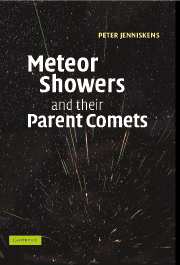Book contents
- Frontmatter
- Dedication
- Contents
- Preface
- Acknowledgements
- Part I Introduction
- Part II Parent bodies
- Part III Young streams from water vapor drag
- Part IV Young streams from comet fragmentation
- 20 Quadrantids
- 21 Broken comets
- 22 Geminids
- 23 The sunskirting Arietids and δ-Aquariids
- 24 α-Capricornids and κ-Cygnids
- 25 The Taurid complex
- Part V Old streams and sporadic meteoroids
- Part VI Impact and relevance of meteor showers
- Appendix
- Tables
- Index
- Units and constants
22 - Geminids
from Part IV - Young streams from comet fragmentation
Published online by Cambridge University Press: 05 July 2015
- Frontmatter
- Dedication
- Contents
- Preface
- Acknowledgements
- Part I Introduction
- Part II Parent bodies
- Part III Young streams from water vapor drag
- Part IV Young streams from comet fragmentation
- 20 Quadrantids
- 21 Broken comets
- 22 Geminids
- 23 The sunskirting Arietids and δ-Aquariids
- 24 α-Capricornids and κ-Cygnids
- 25 The Taurid complex
- Part V Old streams and sporadic meteoroids
- Part VI Impact and relevance of meteor showers
- Appendix
- Tables
- Index
- Units and constants
Summary
It is told that when young Phaethon, born from the God Apollo and a mortal mother in Ethiopia, was given one wish by his father, he choose to ride the Sun chariot. Unable to handle the steeds, he scorched what is now the Sahara. To prevent more harm, he was shot down by Zeus. He fell to his end like a meteor. He was mourned by the Heliades, daughters from an earlier Sun god Helios, and therefore his sisters.
Fred Whipple used this story from Greek mythology to name a minor planet 3200 Phaethon, an asteroid-like object, which he had recognized was in an orbit in the middle of the Geminid shower. That orbit is unusually short, P ∼ 1.59 yr, with a small perihelion distance of q = 0.141 AU. Was Phaethon the parent of the Geminid shower, as suggested by Whipple? This minor planet looked more like an asteroid. And how could a comet in such a short orbit have been active for such a long period of time?
In recent years, many take Phaethon for an interloper from the asteroid belt, in a Geminid-like orbit merely by coincidence. Minor planet Phaethon has many sisters, in dynamically similar short-period orbits, some of which are known asteroids. Such as Icarus, named after another figure from Greek mythology (no relation to the Heliades). Moreover, 3200 Phaethon itself is bluer than sunlight, with a spectrum of taxonomic type B, and not as dark as expected for an extinct comet nucleus. And to drive home the argument, the Geminids ablate like solid asteroidal particles rather than fluffy cometary dust balls, with few if any flares (Fig. 22.1), penetrating deep into Earth's atmosphere.
Others hold on to the opinion that Phaethon is a comet. Phaethon's surface and the way of ablating of the Geminids is on account of the small perihelion distance, which can cause the meteoroids to sinter and melt, thus changing the properties of the dust.
- Type
- Chapter
- Information
- Meteor Showers and their Parent Comets , pp. 397 - 422Publisher: Cambridge University PressPrint publication year: 2006



